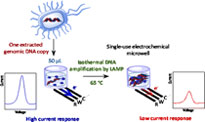Publication
801
ACS Sensors, 1 (7), 904-912, 2016
DOI:10.1021/acssensors.6b00125
|
|
|
|
|
|
 |
Ultimate single-copy DNA detection using real-time electrochemical LAMP
|
|
|
|
Alexandra Martin, Kathryn B. Grant, Franziska Stressmann, Jean-Marc Ghigo, Damien Marchal, and Benoît Limoges
Laboratoire d’Electrochimie Moléculaire, UMR 7591 CNRS, Université Paris Diderot, Sorbonne Paris Cité, 15 rue Jean-Antoine de Baïf, F-75205 Paris Cedex 13, France
Department of Chemistry, Georgia State University, Atlanta, Georgia 30302-3965, United States
Institut Pasteur, Unité de Génétique des Biofilms, Département de Microbiologie, 25-28 rue du Dr. Roux, F-75015 Paris, France
Herein, we report the first successful detection of single DNA copies using real-time electrochemical loop-mediated isothermal amplification (LAMP). Toward this end, real-time electrochemical LAMP amplifications of bacteriophage M13mp18 DNA and of a genomic DNA sequence from the pathogen Flavobacterium columnare were systematically run each with four different redox reporters (i.e., three intercalating reporters with different ds-DNA binding strengths and one nonintercalating probe able to sense the pyrophosphate ion concentration produced during LAMP). In order to provide a reliable, rapid assessment of the LAMP performances, the experiments were carried out using a prototype high-throughput house-built automatized electrochemical read-out device, optimized for parallel monitoring of up to 48 samples. The electrochemical results were then compared to those achieved with conventional real-time fluorescence LAMP and PCR methods (using commercially available fluorescent dyes and standard benchtop equipment)... |

